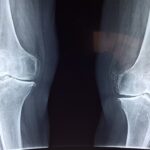Recent research, published in nature genetics, identifies novel genetic influences on osteoporosis, with the potential to empower future research on osteoporosis and potentially lead to new drug targets.
Osteoporosis is a condition that develops slowly over several years and leads to increased bone fragility. Fragile bones are more prone to fracture, with hip, wrist and spine bones being particularly vulnerable to breakage. Whilst there are many factors that affect the chances of an individual developing osteoporosis such as low body weight, certain medical conditions and age, the disease is highly heritable – you are much more likely to develop osteoporosis if your family has a history of the condition. By assessing the genetic determinants of bone mineral density (BMD), the most clinically relevant factor for diagnosis, the researchers were able to create an atlas of genetic influences on osteoporosis.
GWAS identifies gene loci linked to bone mineral density and fracture risk
Using UK Biobank data, the researchers carried out a genome-wide association study (GWAS), with the aim of identifying the common genetic variants associated with estimated bone mineral density (eBMD). The study found 518 genome-wide significant loci, with 301 of these being novel. Additionally, they undertook a GWAS aimed at identifying genetic loci linked with fracture risk. The results revealed 13 loci associated with risk of fracture. As might be expected, genetic variation associated with risk of fracture was also found to be associated with BMD i.e. alleles associated with low eBMD increased fracture risk.
Causal genes linked to genetic loci
Genetic associations in humans, however, rarely result in improved clinical care, usually due to a lack of identification of causal genes at the associated loci. With this in mind, the researchers tested the DNA locations associated with BMD and fracture risk, to see which features of the DNA linked to genes that are known to influence bone biology in humans. This resulted in a set of ‘Target Genes’ that are known to have an effect on bone density and strength in humans – prioritising genes at associated loci for functional testing.
Using mouse models for in-depth analysis
The study initially used mouse models to successfully test the validity of the identified Target Genes, with outlier phenotypes more frequent in mice with disruptions to 126 Target Genes compared with 526 unselected knockout lines. The in vivo and in vitro data produced thus far in the study converged to identify DAAM2 as a highly credible and novel osteoporosis gene.
After discovering that inducing a double strand break in the DAAM2 gene severely impairs mineralization in human bone cells, the researchers used mice obtained from the Wellcome Trust/Sanger Institute (generated as part of the IMPC, using ES cells) for in-depth characterisation of DAAM2. Mice with both versions of their DAAM2 gene disrupted (Daam2tm1a/tm1a) exhibited reduced vertebral bone mineral content accompanied by a small reduction in femur length. Perhaps most significantly, the mutant mice also had markedly reduced bone strength. The increased cortical porosity observed in both male and female Daam2tm1a/tm1a mutants, along with the abnormal bone composition and structure exhibited, allowed the researchers to conclude that this decreased bone strength in Daam2tm1a/tm1a mice was not simply a result of abnormal bone turnover. If DAAM2 proves to be a viable drug target – it could result in a complementary therapeutic strategy for the prevention and treatment of osteoporosis.
The goal of the IMPC is to knock out and phenotype all 20,000 or so genes in the mouse genome, potentially providing major insights into unexplored areas of the mammalian genome. To order IMPC mice, click on the shopping cart on the top part of the gene page of interest or scroll down to “Order Mouse and ES Cells”.
IMPC Data
Details on more phenotype associations for DAAM2 can be found on the IMPC Daam2 gene page. Various phenotype association data can be found such as that shown below.

Research Paper: An atlas of genetic influences on osteoporosis in humans and mice

